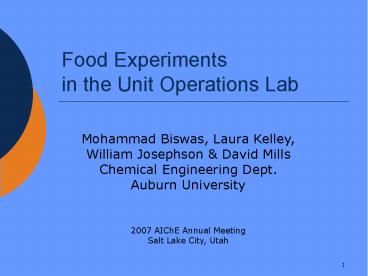Food Experiments in the Unit Operations Lab - PowerPoint PPT Presentation
Title:
Food Experiments in the Unit Operations Lab
Description:
Base Case is w/ KitchenAid mixer & whipping cream. Parameters include. Heavy vs Regular Whipping Cream. Salt amount. KitchenAid vs Manual Agitation. My Expectations ... – PowerPoint PPT presentation
Number of Views:162
Avg rating:3.0/5.0
Title: Food Experiments in the Unit Operations Lab
1
Food Experimentsin the Unit Operations Lab
- Mohammad Biswas, Laura Kelley,
- William Josephson David Mills
- Chemical Engineering Dept.
- Auburn University
- 2007 AIChE Annual Meeting
- Salt Lake City, Utah
2
The Lab
- CHEN 3820 Chemical Engineering Laboratory I
- Jr Level Course
- 2,3 or 4 person groups
- Texts by Geankoplis Taylor
- Objectives include
- Reinforcement of fundamentals
- Tech writing
- Data analysis
- Experiments go for 2 x 3 hour sessions include
- Pump
- Piping
- Fluidized Bed
3
FALL 06 - The Challenge
- Design an experiment that teaches something
about food - My motivation lack of knowledge, desire for
variety, importance of the topic - My expectations chemistry heavy approach
4
The Relevant Literature
5
Available Tools
6
Available Tools
7
Group Alphas Proposal
- Investigate relationship between boiling time
spaghetti stickiness
8
from Group Alpha
Objectives o Generally, you are to determine
the relationship between boiling time and
stickiness of spaghetti noodles. o You should
also consult other sources while investigating
why spaghetti will stick to a ceiling or wall
when it is done.
9
from Group Alpha
Operation Normal o Remove a few spaghetti
noodles from boiling water at regular time
intervals o be sure to use caution when removing
the spaghetti noodles from boiling water o Throw
noodles at a nearby wall to check for al
dente o Record visual observations on firmness,
color, and stickiness
10
from Group Alpha
Background Students should be able to utilize
resources from outside of the classroom such as
the internet to explore what is changing in the
noodles with respect to cooking time. Students
should understand that it is the starch in the
noodles that gives the stickiness to them. As the
noodles cook longer the starch is leached from
the noodles into the surrounding water. Some of
the starch breaks down into the sugar dextrin,
coats the noodles and makes them sticky when
removed from the water. Maltose and glucose are
also products of the starch degradation and
contribute to the pastas stickiness. Students
should examine what would happen if the noodles
were cooked in a very large amount of water, or a
very small amount of water? The starch
concentration would vary as would the stickiness
of the noodles.
11
from Group Alpha
Discussion Students should understand and state
that as the length of cooking time is increasing
the concentration of starch in the surrounding
water is increasing. This means that as cooking
time increases the spaghetti noodles should be
growing stickier and stick better to a wall. It
should also be understood that as cooking time
increases more water is impregnating the noodles
themselves, moving closer toward being fully
saturated. This causes the noodle to lose
rigidity and become more pliable.
12
Group Bravos Proposal
- The Fat-O-Meter (aka Hot Fat)
Substance Heat Capacity (kJ/kg)
Water 4.184
Whole Milk 3.85
Oil 2.01
13
Group Bravos Proposal
- Q m CP ?T
- Use the Easy Bake to determine fat content?
- Procedure standard sample size, standard
heating time, monitor ?T
14
Group Bravo Results
Substance Fat Content in Sample (g) Temperature Change from Heating
Coffee 0 27.4
Tea 0 33.9
Orange Starburst Smoothie 1 44.3
50/50 Mixture of Smoothie and Water 0.5 40.9
Whole Milk 1 43.7
Chocolate Milk 1.125 46.9
Olive Oil 28 95.6
15
Group Bravo Results
16
Group Bravo Results
17
Group Charlies Proposal
- Generate Drying Curves
18
Group Charlies Proposal
- Bake Cookies
- Vary initial water content, shape
- Monitor water content via weighing
19
Group Charlie Results
20
Group Charlie Results
21
SPRING 06
- No food experiment
- But.
22
SUMMER 07 beyond
- Butter Experiment has been part of CHEN 3820
- Base Case is w/ KitchenAid mixer whipping cream
- Parameters include
- Heavy vs Regular Whipping Cream
- Salt amount
- KitchenAid vs Manual Agitation
- My Expectations
23
Butter Results
24
Butter Results
25
Butter Results
26
Butter Results
27
Butter Results Background Understanding
Fat in milk exist as droplets covered in a
membrane. The churning process breaks this
membrane exposing the fat globules. Additional
churning results in the globules coalescing into
a separate fat phase3. All fats, including milk
fat, are triesters of glycerol. These molecules
contain three carboxyl groups and have three long
organic tails as can be seen in the saturated fat
molecule seen in Fig.2. Figure 2 Saturated fat
molecule
http//scholar.hw.ac.uk/site/chemistry/graphics/sa
turfat.gif As was previously stated, adding salt
to milk or whipped cream can reduce churning
time. This phenomenon could be the result of the
electrostatic interactions between the long
organic chains of the fat and the ions introduced
into the milk emulsion.
28
The Future of Food Experimentsin CHEN 3820
- Butter will continue, will tweak (e.g., yield)
- Mixing Experiment?
- Corn Starch?
- May repeat student designed experiment
29
A Sincere Thank You
To the students in CHEN 3820 Chemical Engineering
Laboratory I































